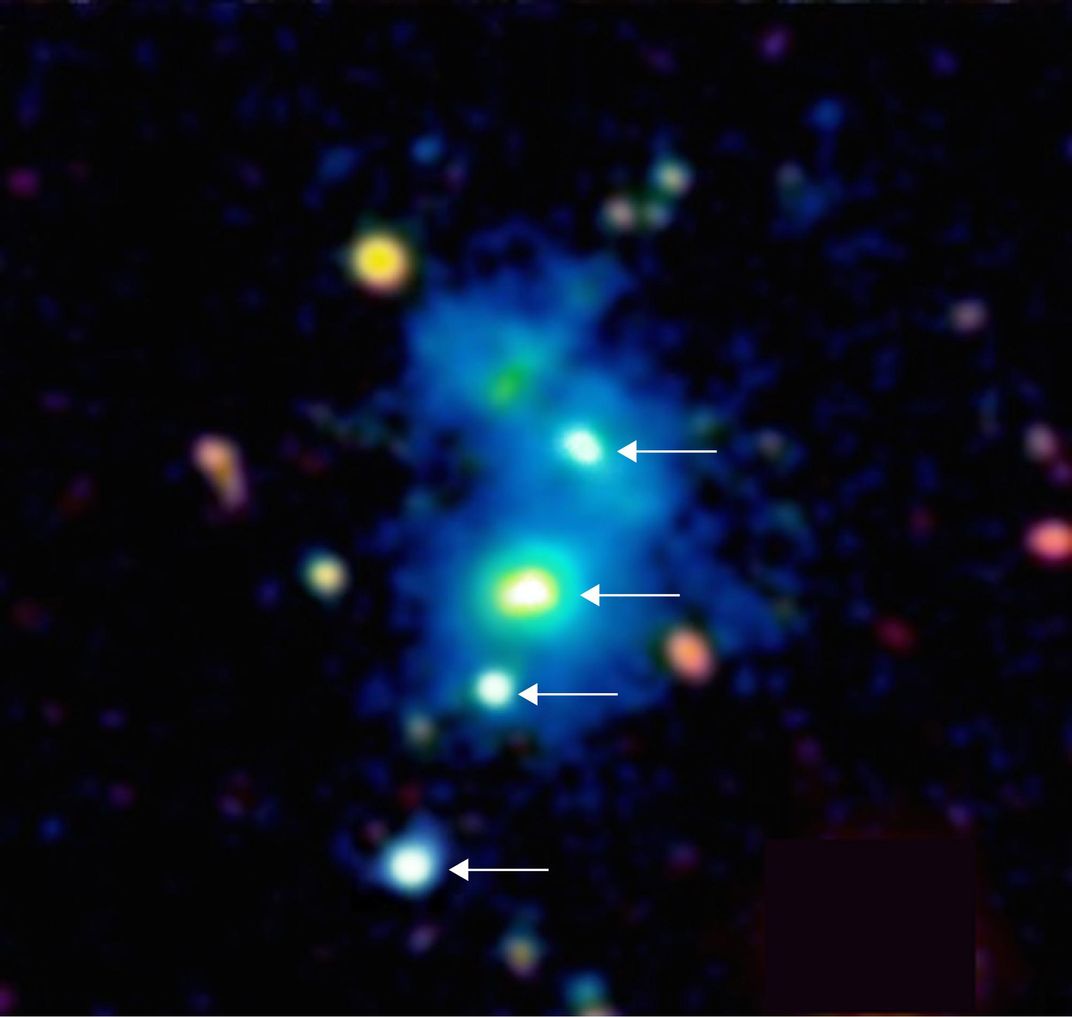Rare Quartet of Quasars Found in the Early Universe
The quirky set of extremely bright black holes challenges theories for how the cosmos reached its current structure
/https://tf-cmsv2-smithsonianmag-media.s3.amazonaws.com/filer/46/73/4673978c-9c84-4104-8d92-55e549b06d4c/202407main_image_958_946-710.jpg)
The odds of success would make a Vegas bookie sit up and take notice. But in a one-in-10 million chance, astronomers surveying the sky have found a group of four tightly packed quasars in one of the most distant parts of the universe. The rare grouping may be a nascent galaxy cluster, and its unusually cold cradle of gas could prompt a re-think of how we model the early universe.
Quasars are among the brightest objects known—according to NASA, each one gives off more energy than 100 mature galaxies combined. But quasars are found only in the far reaches of the universe and can't be seen with the naked eye. Because of the time it takes light to travel that far, detecting such distant objects is akin to seeing back in time, so astronomers think quasars are the seeds of young galaxies, powered by gases falling into the supermassive black holes at their cores. As matter falls inward and gets close to the speed of light, it emits radiation that we can pick up with telescopes.
The quasar phase doesn't last long, only about a thousandth of a galaxy's lifetime. After that, the brightness dies down as the inflow of matter slows, says study leader Joseph Hennawi, an astrophysicist at the Max Planck Institute in Germany. Seeing any two quasars close together while they are still bright is a chancy business, so his team wasn't sure what they'd find when they set out to survey quasars using the W.M. Keck Observatory in Hawaii. To their surprise, they quickly pinpointed four of them in close proximity, cosmically speaking. The quartet is huddled up in an area of sky less than 600,000 light-years across that sits about 10 billion light-years from Earth.
"The authors found it by investigating the environment of just 29 bright quasars," says Michele Trenti, a senior lecturer at the University of Melbourne's School of Physics. "So at face value it seems like winning the lottery with a handful of tickets."
That's not all that was strange about this quasar quartet. The foursome was found inside a cloud of cold, dark gas, and the team's observations suggest that similar clouds surround about 10 percent of the tens of thousands of known quasars. That's odd, because according to current theories, quasars in groups like this should be surrounded by hot plasma, or ionized gas, at a temperature of about 10 million degrees.
“What this means is that there is some physical process that the models aren’t capturing,” says Hennawi, whose team reports the discovery this week in Science.

So what is going on? The area the astronomers were observing has a lot more galaxies in it than other regions, which hints that the quasar quartet might represent the early stages of a galaxy cluster forming. Galaxy clusters are among the largest objects in the universe, measuring hundreds of millions of light-years end to end. The Milky Way, for example, is part of a cluster of 54 galaxies called the Local Group, which is about 10 million light-years across.
Figuring out how these unusual quasar groupings formed may aid our understanding of how the universe grew and evolved—akin to tracing the growth of a fetus into an adult so we can understand how a population takes shape. Tinkering with the computer simulations that scientists use to test models of the early universe could help, Hennawi says. One problem, though, is that the simulations have to cover a wide range of scales, from hundreds of millions of light-years to a few thousand. "That's a lot of dynamic range," Hennawi says. Quasars are relatively small objects, each about the size of our solar system, so it can be difficult for one model to show how they fit into the big picture.
For instance, it's possible that a lot of closely spaced proto-galaxies collided and spewed out gas in the region, creating the giant quasar-filled cloud. But that still doesn't explain the gas temperature very well. Luckily, this is probably not the only quartet of its kind in the universe, and tracking down others will help astronomers figure out how they form. “Now that this kind of nebula has been found, we know how to see them,” Hennawi says.